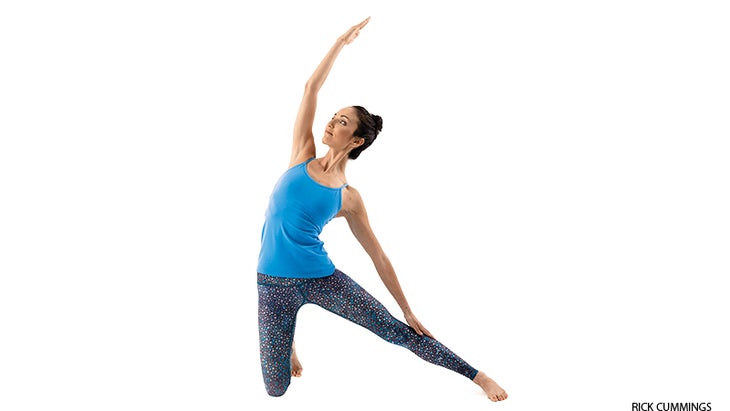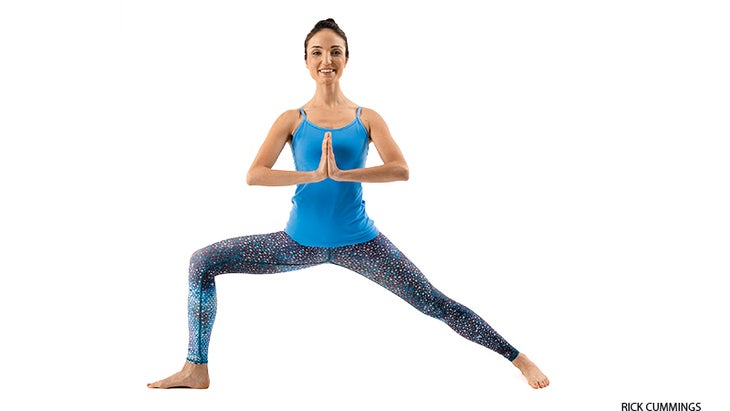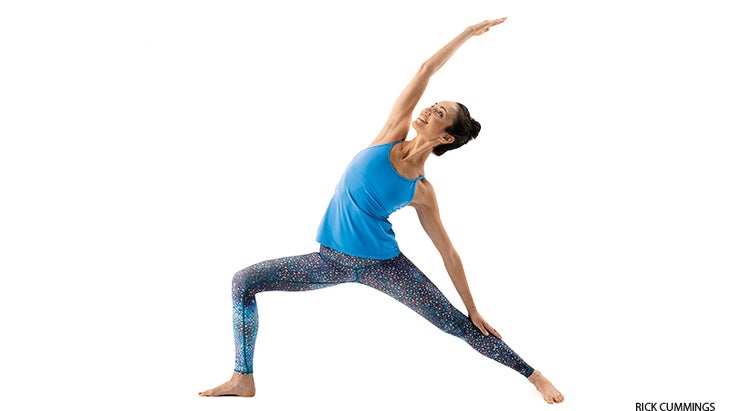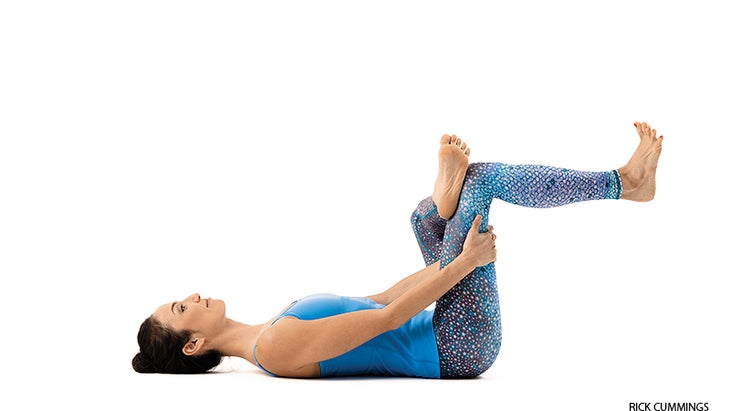Heading out the door? Read this article on the new Outside+ app available now on iOS devices for members! Download the app.
Take a moment to think about your breath: Is it deep or shallow? Slow or fast? It’s interesting that it can take a few moments to figure out our patterns of breathing, even though it’s something we’re always doing. The reason most of us can’t pinpoint what’s happening right away is because breathing happens unconsciously: It’s part of the autonomic nervous system, which tells our internal organs (like the diaphragm and lungs) to function without our conscious control. Yet unlike other functions our autonomic nervous system regulates—like digestion and circulation—breathing can also be voluntarily regulated. And when I teach patients and yoga students how to do this, it can transform their practice.
For starters, regulating the breath through a technique commonly called “belly breathing” creates more capacity to take bigger breaths. People often tell me that just 10 minutes of belly breathing seems to help their breathing feel “freer.” In turn, this leads them to tune in to the energetic center in the abdominal area, where the “belly brain” lives. Finally, there’s an energetic shift that happens when you’re able to control your breath with belly breathing. You may start to see the breath as not just air, but also as energy moving within your body. When this happens, you’re really tapping into the power of breathing.
See alsoThe Science of Breathing
Before learning how to belly-breathe, it helps to understand the basic anatomy of the breath. Respiration happens in two phases: inspiration (inhaling) and expiration (exhaling). Normal, restful breathing primarily uses the diaphragm, whereas exercise or exertion recruits the accessory muscles of breathing—the intercostal and upper thoracic muscles, near the ribs and chest, respectively—to further expand the chest. A full yogic breath is based on diaphragmatic, or belly, breathing, but includes intercostal and upper thoracic breathing as well.
When you inhale, your diaphragm contracts, flattening out and pressing down on the abdomen, which in turn expands the chest. At the same time, the external intercostal muscles (located between the ribs) work to lift and expand the chest by drawing the ribs upward and out, increasing the capacity for volume in the chest. A deep breath also activates the accessory muscles of breathing, including the pectorals, serratus anterior, rhomboids, and middle trapezius, which all work to expand and lift the upper chest. Finally, there are the scalene muscles, which run from the cervical spine (a.k.a. your neck) to the upper two ribs. You can feel these muscles contract by placing your fingers on either side of your neck and taking a deep, sharp inhalation. The scalene muscles work along with the diaphragm and intercostals to balance the expansion of the lower ribs by lifting the upper chest.
This increased volume in the chest not only makes room for the air coming into the lungs, it also changes the atmospheric pressure inside the lungs, creating a vacuum that actually draws air in. At the end of inhalation, the diaphragm relaxes, returning to its domelike structure, which initiates your exhale. This, along with the elastic recoil of the structures of the chest wall and contraction of the internal intercostals and accessory muscles of exhalation, raises the pressure within the thorax (the area between the neck and the abdomen), causing the air in the lungs to be expelled.
See alsoSadie Nardini’s 360-Degree Breath to Fire Up the Solar Plexus
Since breathing starts with the diaphragm, I begin breathing techniques with belly breathing. Lie down, with one block under your upper back and another under your head; you can also lie over a bolster. As you inhale, actively expand your abdomen—though try not to let your chest expand until the last few seconds of your inhale. (If you allow your abdominal area, and not your chest, to expand, it’ll teach you to breathe into this lower region—especially helpful for those who can’t easily access belly breathing.) Then release and exhale, letting the abdomen fall and tightening it at the very end of your exhalation: This fully pushes your diaphragm up into its domelike shape. Repeat this cycle for three minutes, and build up to five or six minutes over time. When you feel like you’ve got the hang of this, transition into a seated position and do the same thing.
To prep your body to engage the muscles of breathing, you may want to create physical space with asana so that tight muscles don’t inhibit your effort to expand your breath. The goal of developing a deeper belly breath is to enhance your awareness of the breath circumferentially —around your entire thorax—including your sides and front and back body. To do this, practice poses that release tension from the belly, ribs, and back by stretching the thorax up and away from the pelvis. Try the poses below before your pranayama practice, and then see how much freer your breath feels and how much more in tune you become with your belly brain.
What is the “belly brain”?
This may come as a surprise coming from me, an orthopedic surgeon, but we actually have a brain in the solar plexus (located at the pit of the stomach) that’s referred to as the “belly brain.” It is your gut feeling, and it functions largely unconsciously. In fact, most people only become aware of the belly brain in extreme situations, in which survival instincts kick in and override the “thinking brain.”
Nearly all of the practices developed to heighten awareness of the “belly brain” involve some variation of belly breathing. Beyond the calming effects of a regular belly-breathing practice, there’s a good chance you’ll also have enhanced awareness of any negative influences affecting you beyond your conscious awareness.
See alsoTwo Fit Moms: 3 Breathing Exercises for Stillness and Peace
4 Poses to Prep for Belly Breathing
These poses help release tension from the belly, ribs, and back. Try them before belly breathing—or any pranayama practice.
Gate Pose

Parighasana
Kneel on your right leg and stretch your left leg out to the side, turning the foot so that the toes point toward the corner of your mat. Inhale and extend your arms to either side at shoulder height. Keeping your sides long, exhale and bend leftward to bring your left hand toward your left ankle. Sweep your right hand overhead, feeling length in your right side body. Stay for up to a minute; inhale to come up, and then switch sides.
See alsoTaking Sides: Gate Pose
Warrior Pose II

Virabhadrasana II
Standing with your legs about four feet apart, turn your right foot 90 degrees to the right and your left foot slightly to the right. Bring your hands to Anjali Mudra at your heart center. Keep your left leg straight and strong. Exhale and bend your right knee until your thigh is about parallel with the floor, with your knee directly above your heel. Press into your hands as you fill the entire circumference of your belly and rib cage with one complete breath. Hold for three breaths.
See alsoHappiness Toolkit: Belly Breathing Meditation to Build Boundaries
Reverse Warrior

From Warrior II, flip your right palm up and inhale to reach that arm up and overhead. Lean back, inhaling deeply, and release any tension in your belly and around the diaphragm’s attachments to the lower-front rib cage. Exhale fully, and then inhale again to lift your torso up away from your pelvis as you exhale back into Warrior II. Move between Warrior II and Reverse Warrior several times on the right side; repeat this sequence on the left.
See alsoInside YJ’s YTT: Discovering the Power of the Breath + the Mind
Reverse Pigeon

Lie on your back. Place your left ankle on your right knee and draw your right knee toward your chest, clasping your hands around your shin or behind your thigh (or use a strap). Bring your right foot and shin parallel to the floor and release any tension in the shoulders. Deepen your breath against your back ribs on the floor, and use the breath to increase the stretch all the way down the torso. Observe how deepening your breath enhances the stretch in the left hip. Stay as long as you like, and then switch sides.
See alsoPillars of Power: 3 Ways the Breath Is Key in Baptiste Yoga
About Our Pros

Teacher Ray Long, MD, is an orthopedic surgeon in Detroit and the founder of Bandha Yoga, a website and book series dedicated to the anatomy and biomechanics of yoga. He trained with B.K.S. Iyengar. Model Geenie Celento is a Denver-based yoga teacher.